fuel TOYOTA HIGHLANDER HYBRID 2009 XU40 / 2.G Owners Manual
[x] Cancel search | Manufacturer: TOYOTA, Model Year: 2009, Model line: HIGHLANDER HYBRID, Model: TOYOTA HIGHLANDER HYBRID 2009 XU40 / 2.GPages: 592, PDF Size: 11.8 MB
Page 2 of 592
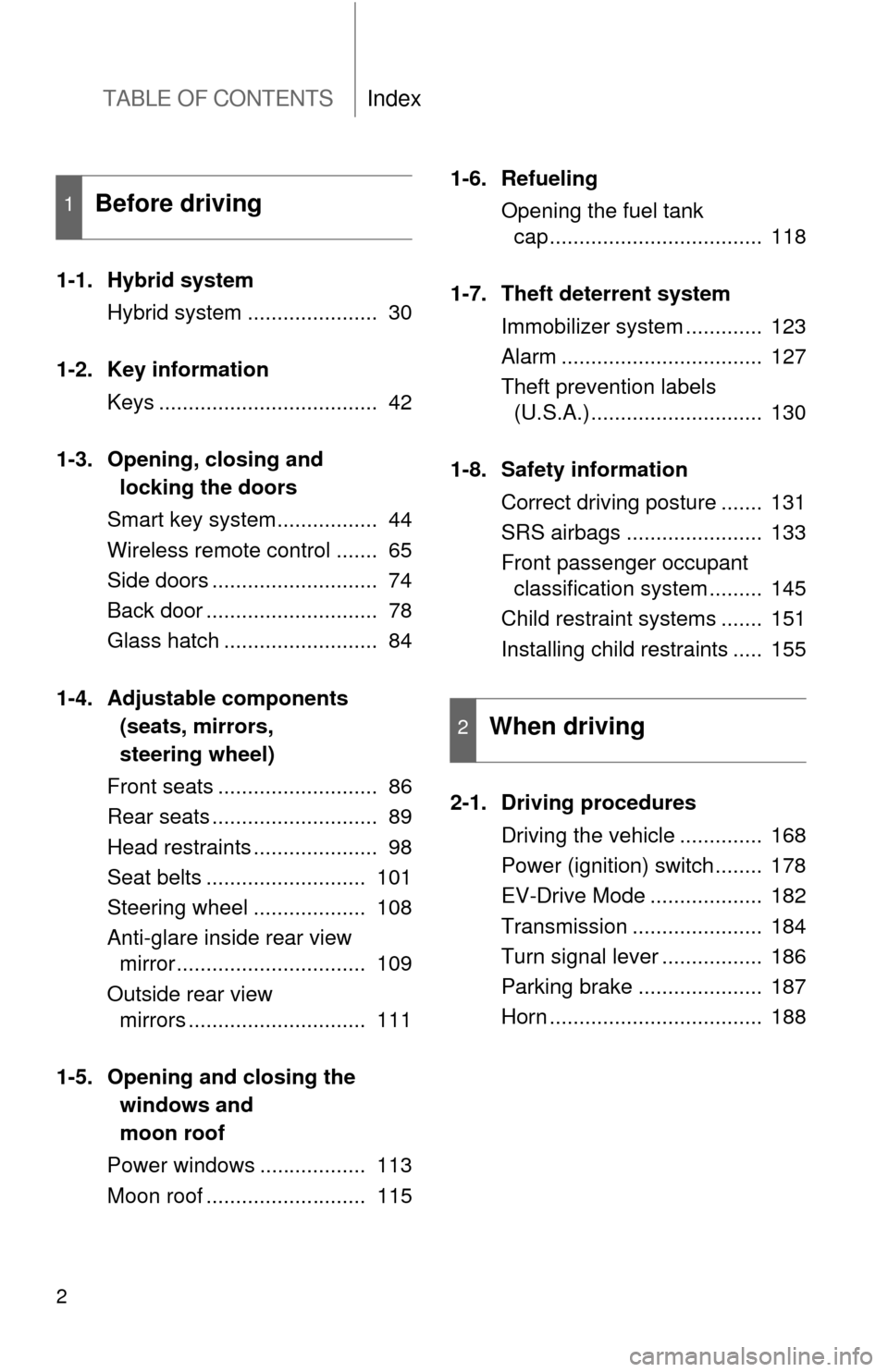
TABLE OF CONTENTSIndex
2
1-1. Hybrid systemHybrid system ...................... 30
1-2. Key information Keys ..................................... 42
1-3. Opening, closing and
locking the doors
Smart key system................. 44
Wireless remote control ....... 65
Side doors ............................ 74
Back door ............................. 78
Glass hatch .......................... 84
1-4. Adjustable components (seats, mirrors,
steering wheel)
Front seats ........................... 86
Rear seats ............................ 89
Head restraints ..................... 98
Seat belts ........................... 101
Steering wheel ................... 108
Anti-glare inside rear view mirror ................................ 109
Outside rear view mirrors .............................. 111
1-5. Opening and closing the windows and moon roof
Power windows .................. 113
Moon roof ........................... 115 1-6. Refueling
Opening the fuel tank cap .................................... 118
1-7. Theft deterrent system Immobilizer system ............. 123
Alarm .................................. 127
Theft prevention labels (U.S.A.)............................. 130
1-8. Safety information Correct driving posture ....... 131
SRS airbags ....................... 133
Front passenger occupant classification system ......... 145
Child restraint systems ....... 151
Installing child restraints ..... 155
2-1. Driving procedures Driving the vehicle .............. 168
Power (ignition) switch........ 178
EV-Drive Mode ................... 182
Transmission ...................... 184
Turn signal lever ................. 186
Parking brake ..................... 187
Horn .................................... 188
1Before driving
2When driving
Page 6 of 592
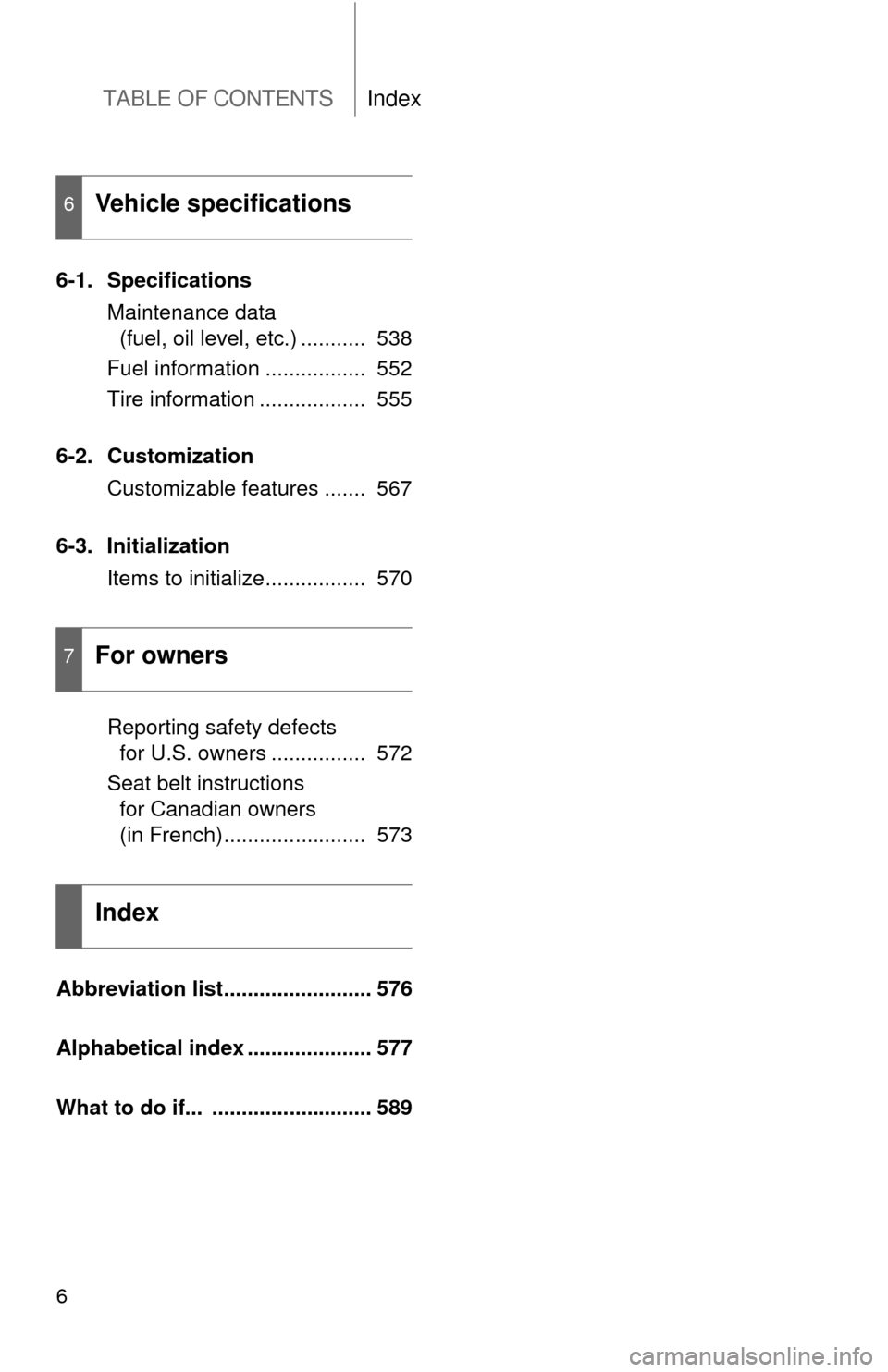
TABLE OF CONTENTSIndex
6
6-1. SpecificationsMaintenance data (fuel, oil level, etc.) ........... 538
Fuel information ................. 552
Tire information .................. 555
6-2. Customization Customizable features ....... 567
6-3. Initialization Items to initialize................. 570
Reporting safety defects for U.S. owners ................ 572
Seat belt instructions for Canadian owners
(in French) ........................ 573
Abbreviation list......................... 576
Alphabetical index ..................... 577
What to do if... ........................... 589
6Vehicle specifications
7For owners
Index
Page 9 of 592
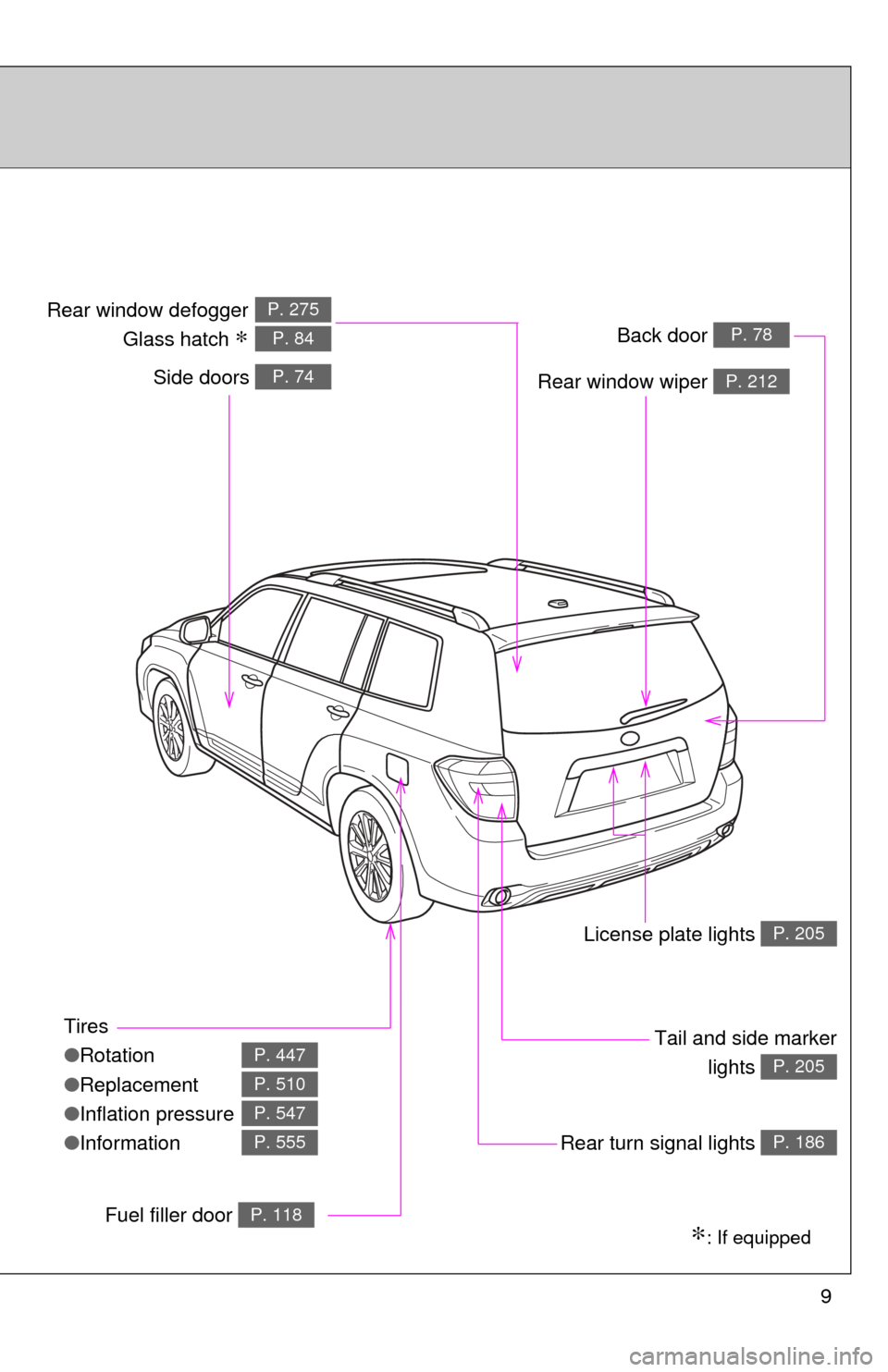
9
Tires
●Rotation
● Replacement
● Inflation pressure
● Information
P. 447
P. 510
P. 547
P. 555
∗: If equipped
Back door P. 78
Side doors P. 74
Tail and side marker
lights
P. 205
Rear window wiper P. 212
Rear window defogger
Glass hatch ∗
P. 275
P. 84
License plate lights P. 205
Rear turn signal lights P. 186
Fuel filler door P. 118
Page 16 of 592
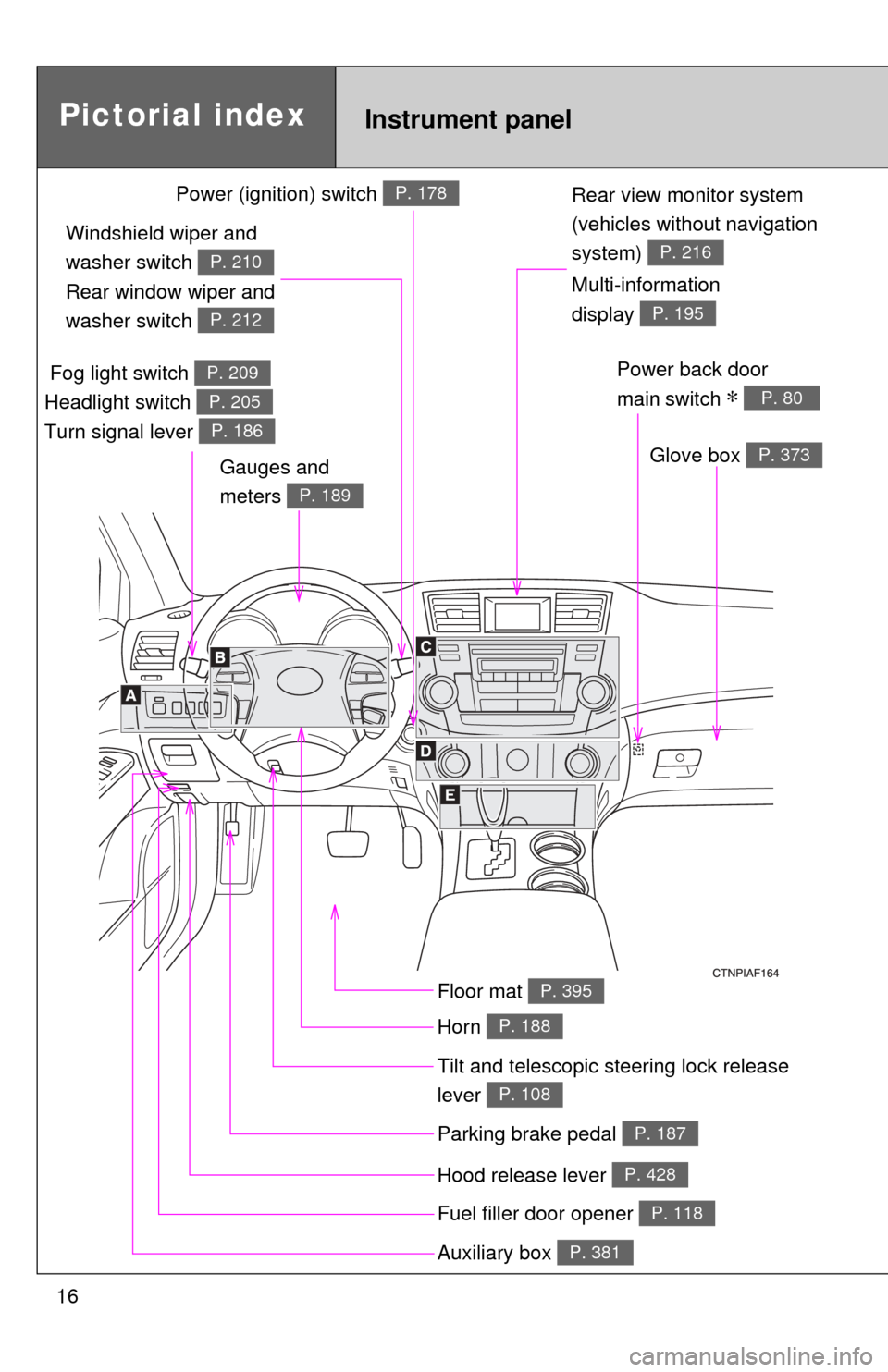
16
Rear view monitor system
(vehicles without navigation
system)
P. 216
Tilt and telescopic steering lock release
lever
P. 108
Glove box P. 373
Pictorial indexInstrument panel
Power back door
main switch
∗ P. 80
Parking brake pedal P. 187
Hood release lever P. 428
Auxiliary box P. 381
Power (ignition) switch P. 178
Multi-information
display
P. 195
Fuel filler door opener P. 118
Fog light switch
Headlight switch
Turn signal lever P. 209
P. 205
P. 186
Windshield wiper and
washer switch
Rear window wiper and
washer switch
P. 210
P. 212
Gauges and
meters
P. 189
Floor mat P. 395
Horn P. 188
Page 24 of 592

24
For your information
Main Owner’s Manual
Please note that this manual covers all models and all equipment, including
options. Therefore, you may find some explanations for equipment not
installed on your vehicle.
All specifications provided in this manual are current at the time of printing.
However, because of the Toyota policy of continual product improvement,
we reserve the right to make changes at any time without notice.
Depending on specifications, the vehicle shown in the illustrations may differ
from your vehicle in terms of equipment.
Accessories, spare parts and modification of your Toyota
A wide variety of non-genuine spare parts and accessories for Toyota
vehicles are currently available on the market. You should know that these
parts are not covered by Toyota warranty and that Toyota is not responsible
for their performance, repair, or replacement, or for any damage they may
cause to, or adverse effect they may have on, your Toyota vehicle.
This vehicle should not be modified with non-genuine Toyota products.
Modification with non-genuine Toyota products may affect performance,
safety or durability, and may even violate governmental regulations. In
addition, damage or performance problems resulting from the modification
may not be covered under warranty.
Installation of a mobile two-way radio system
As the installation of a mobile two-way radio system in your vehicle may
affect electronic systems such as the multi-port fuel injection system/sequen-
tial multi-port fuel injection system, cruise control system, anti-lock brake
system, SRS airbag system or seat belt pretensioner system, be sure to
check with your Toyota dealer for precautionary measures or special instruc-
tions regarding installation.
High voltage parts and cables on the hybrid vehicles emit approximately the
same amount of electromagnetic waves as the conventional gasoline pow-
ered vehicles or home electronic appliances despite of their electromagnetic
shielding.
Page 29 of 592
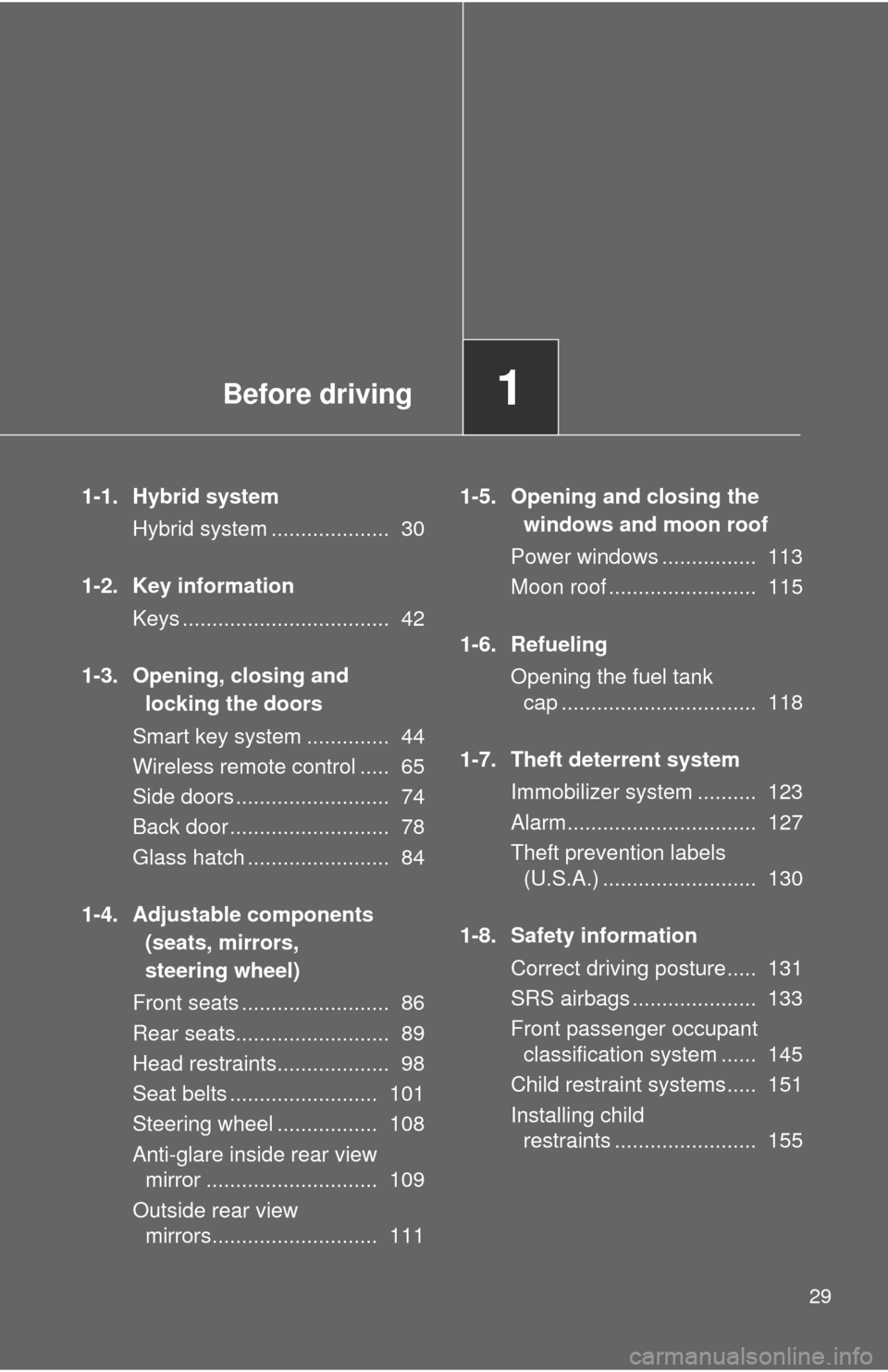
Before driving1
29
1-1. Hybrid systemHybrid system .................... 30
1-2. Key information Keys ................................... 42
1-3. Opening, closing and locking the doors
Smart key system .............. 44
Wireless remote control ..... 65
Side doors .......................... 74
Back door ........................... 78
Glass hatch ........................ 84
1-4. Adjustable components (seats, mirrors,
steering wheel)
Front seats ......................... 86
Rear seats.......................... 89
Head restraints................... 98
Seat belts ......................... 101
Steering wheel ................. 108
Anti-glare inside rear view mirror ............................. 109
Outside rear view mirrors............................ 111 1-5. Opening and closing the
windows and moon roof
Power windows ................ 113
Moon roof ......................... 115
1-6. Refueling Opening the fuel tank cap ................................. 118
1-7. Theft deterrent system Immobilizer system .......... 123
Alarm................................ 127
Theft prevention labels (U.S.A.) .......................... 130
1-8. Safety information Correct driving posture..... 131
SRS airbags ..................... 133
Front passenger occupant classification system ...... 145
Child restraint systems..... 151
Installing child restraints ........................ 155
Page 30 of 592
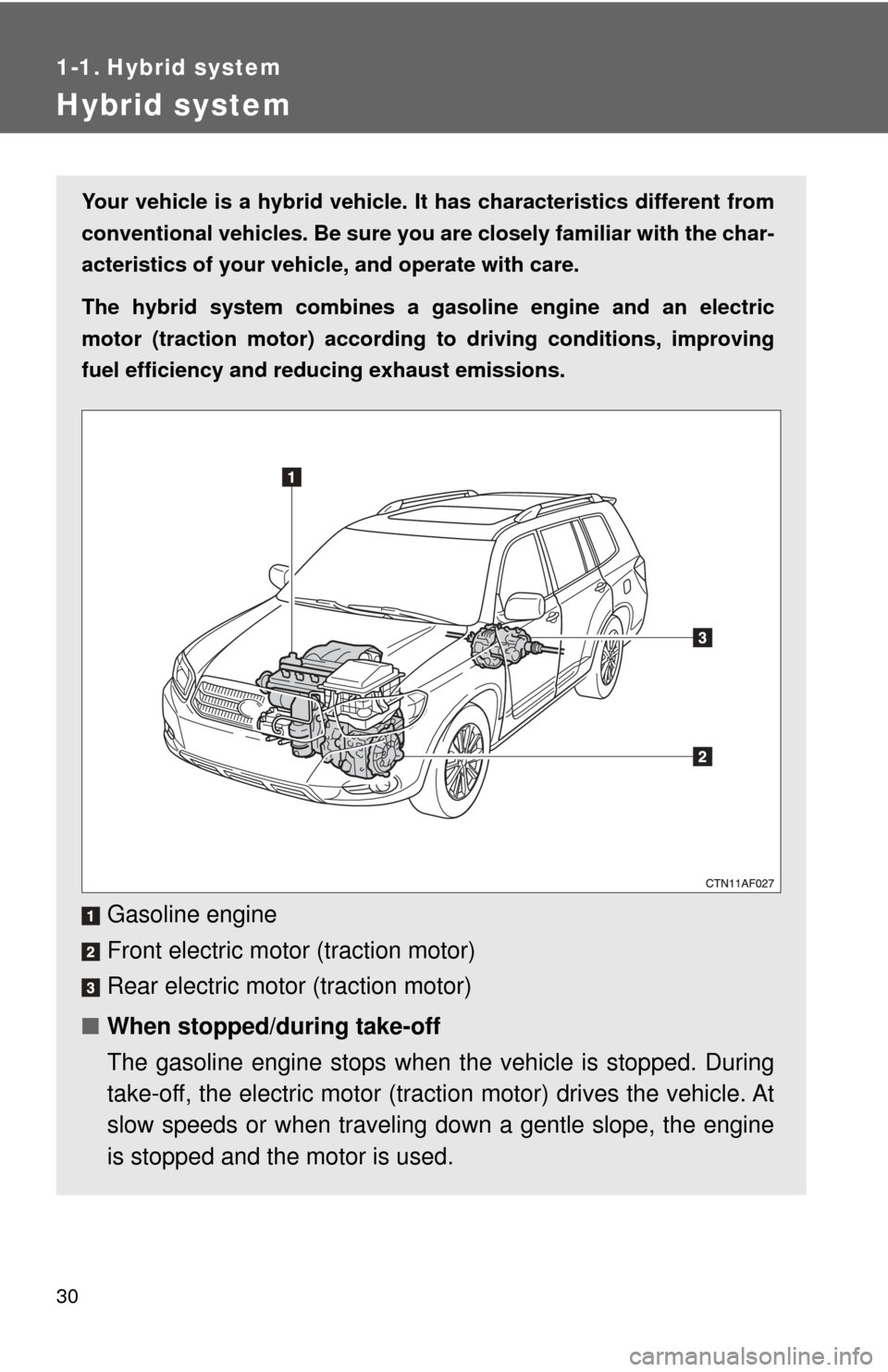
30
1-1. Hybrid system
Hybrid system
Your vehicle is a hybrid vehicle. It has characteristics different from
conventional vehicles. Be sure you are closely familiar with the char-
acteristics of your vehicle, and operate with care.
The hybrid system combines a gasoline engine and an electric
motor (traction motor) according to driving conditions, improving
fuel efficiency and reducing exhaust emissions.
Gasoline engine
Front electric motor (traction motor)
Rear electric motor (traction motor)
■ When stopped/during take-off
The gasoline engine stops when the vehicle is stopped. During
take-off, the electric motor (tract ion motor) drives the vehicle. At
slow speeds or when traveling down a gentle slope, the engine
is stopped and the motor is used.
Page 34 of 592
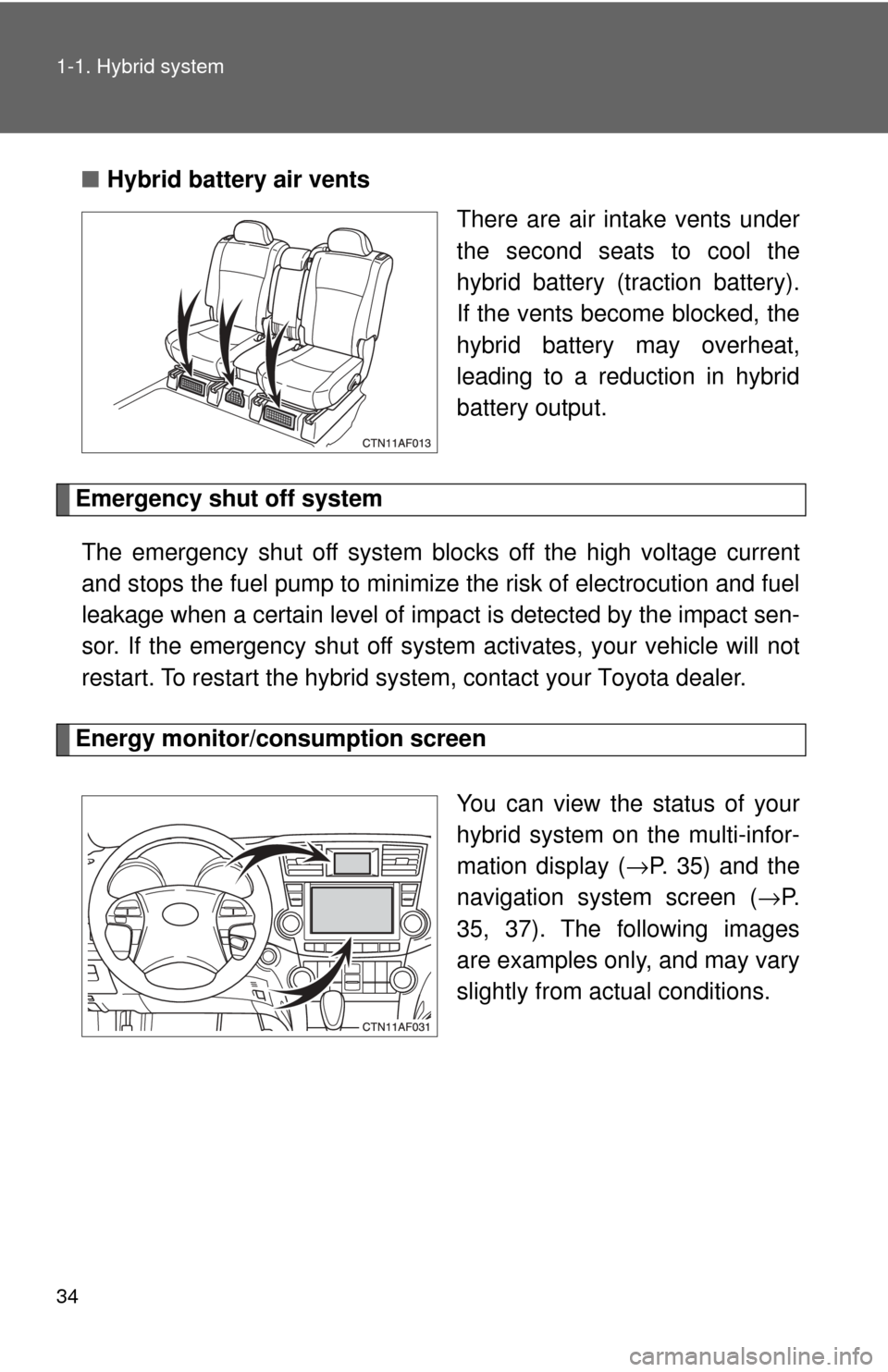
34 1-1. Hybrid system
■Hybrid battery air vents
There are air intake vents under
the second seats to cool the
hybrid battery (traction battery).
If the vents become blocked, the
hybrid battery may overheat,
leading to a reduction in hybrid
battery output.
Emergency shut off system
The emergency shut off system bloc ks off the high voltage current
and stops the fuel pump to minimize the risk of electrocution and fuel
leakage when a certain level of impa ct is detected by the impact sen-
sor. If the emergency shut off syste m activates, your vehicle will not
restart. To restart the hybrid sy stem, contact your Toyota dealer.
Energy monitor/consumption screen
You can view the status of your
hybrid system on the multi-infor-
mation display (→P. 35) and the
navigation system screen ( →P.
35, 37). The following images
are examples only, and may vary
slightly from actual conditions.
Page 37 of 592
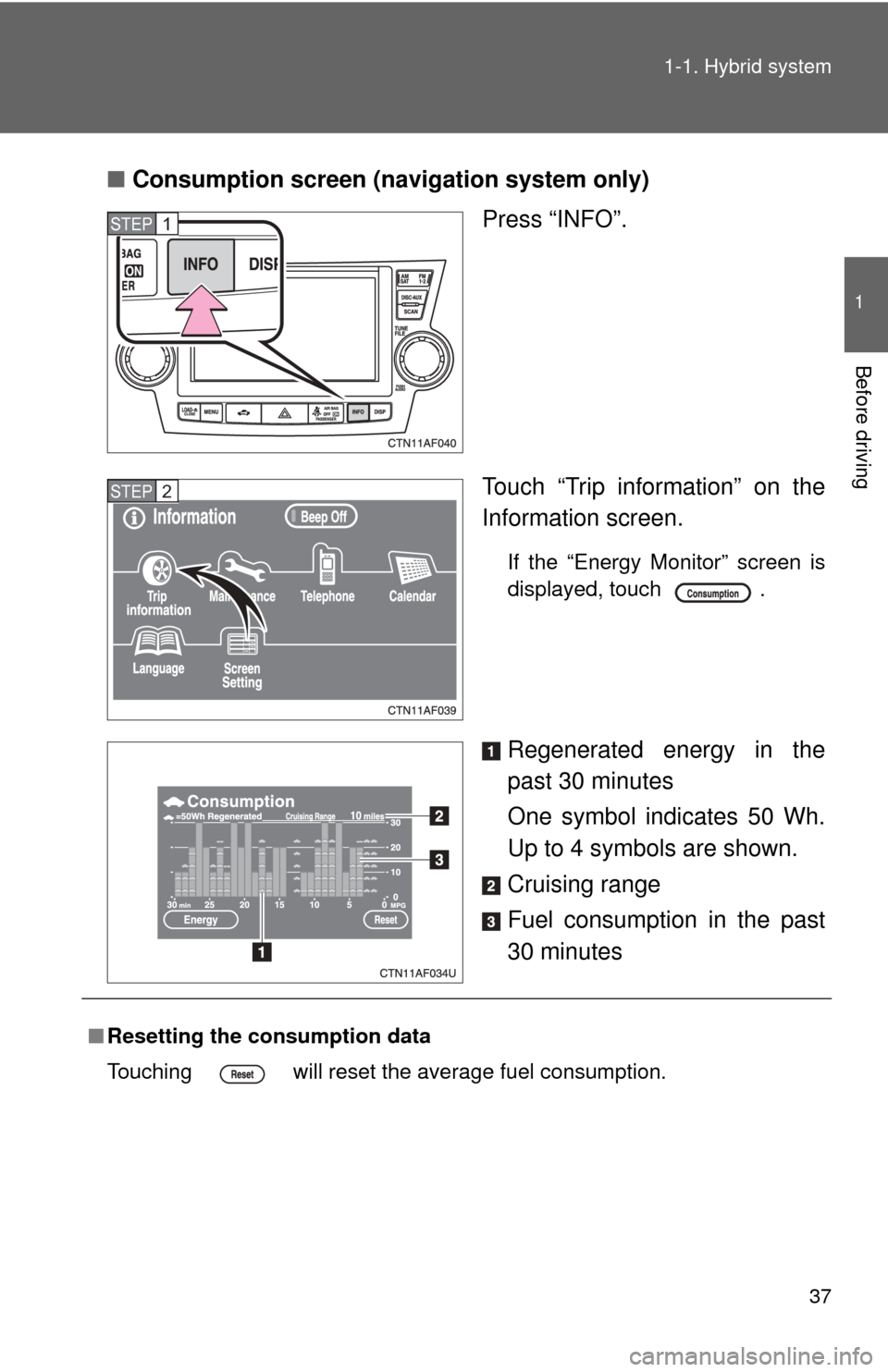
37
1-1. Hybrid system
1
Before driving
■
Consumption screen (navigation system only)
Press “INFO”.
Touch “Trip information” on the
Information screen.
If the “Energy Monitor” screen is
displayed, touch .
Regenerated energy in the
past 30 minutes
One symbol indicates 50 Wh.
Up to 4 symbols are shown.
Cruising range
Fuel consumption in the past
30 minutes
STEP1
STEP2
■Resetting the consumption data
Touching will reset the average fuel consumption.
Page 38 of 592
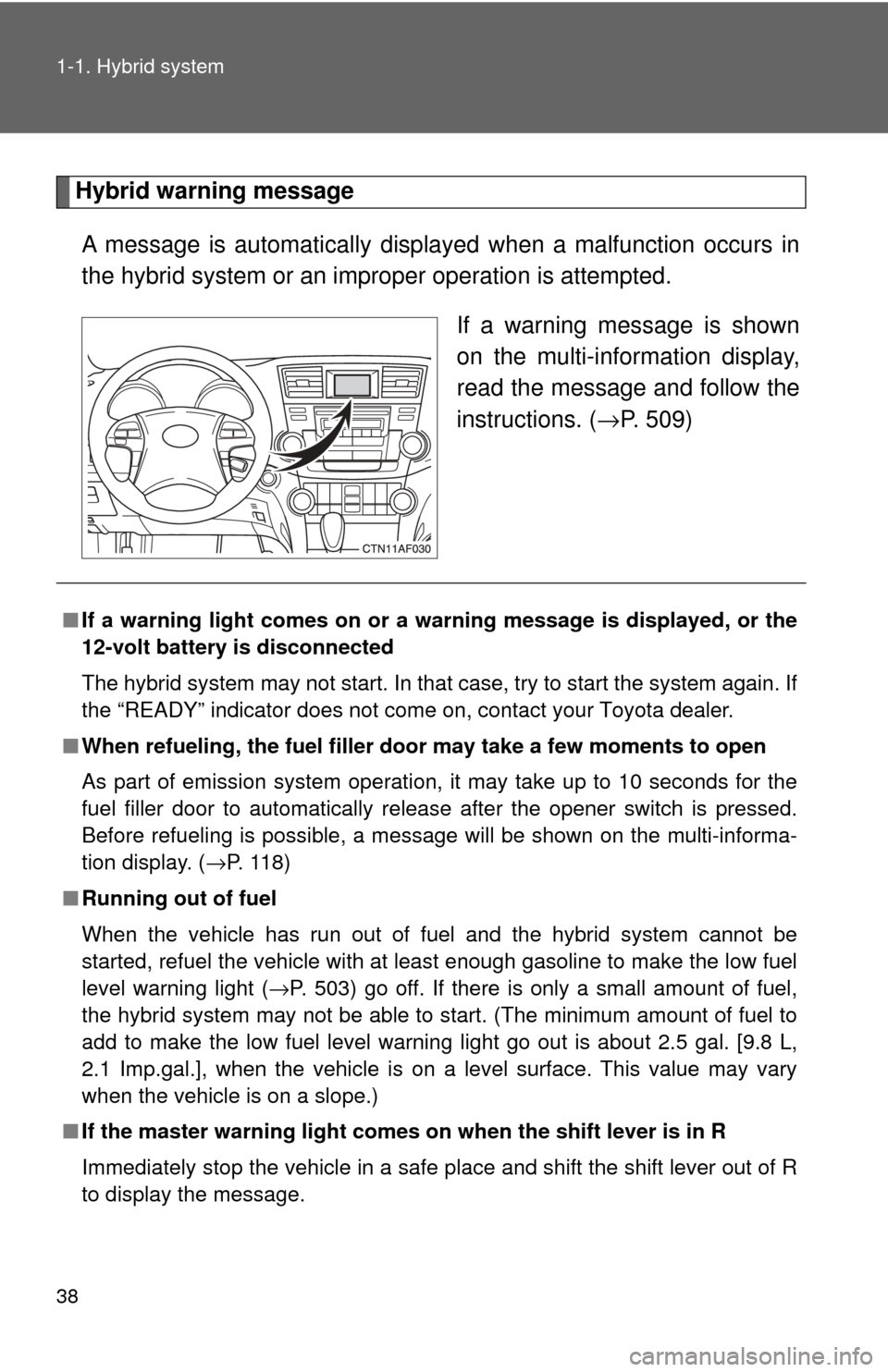
38 1-1. Hybrid system
Hybrid warning messageA message is automatically displa yed when a malfunction occurs in
the hybrid system or an impr oper operation is attempted.
If a warning message is shown
on the multi-information display,
read the message and follow the
instructions. ( →P. 509)
■If a warning light comes on or a wa rning message is displayed, or the
12-volt battery is disconnected
The hybrid system may not start. In that case, try to start the system again. If
the “READY” indicator does not come on, contact your Toyota dealer.
■ When refueling, the fuel filler door may take a few moments to open
As part of emission system operation, it may take up to 10 seconds for the
fuel filler door to automatically release after the opener switch is pressed.
Before refueling is possible, a message will be shown on the multi-informa-
tion display. ( →P. 118)
■ Running out of fuel
When the vehicle has run out of fuel and the hybrid system cannot be
started, refuel the vehicle with at least enough gasoline to make the low fuel
level warning light ( →P. 503) go off. If there is only a small amount of fuel,
the hybrid system may not be able to start. (The minimum amount of fuel to
add to make the low fuel level warning light go out is about 2.5 gal. [9.8 L,
2.1 Imp.gal.], when the vehicle is on a level surface. This value may vary
when the vehicle is on a slope.)
■ If the master warning light comes on when the shift lever is in R
Immediately stop the vehicle in a safe place and shift the shift lever out of R
to display the message.